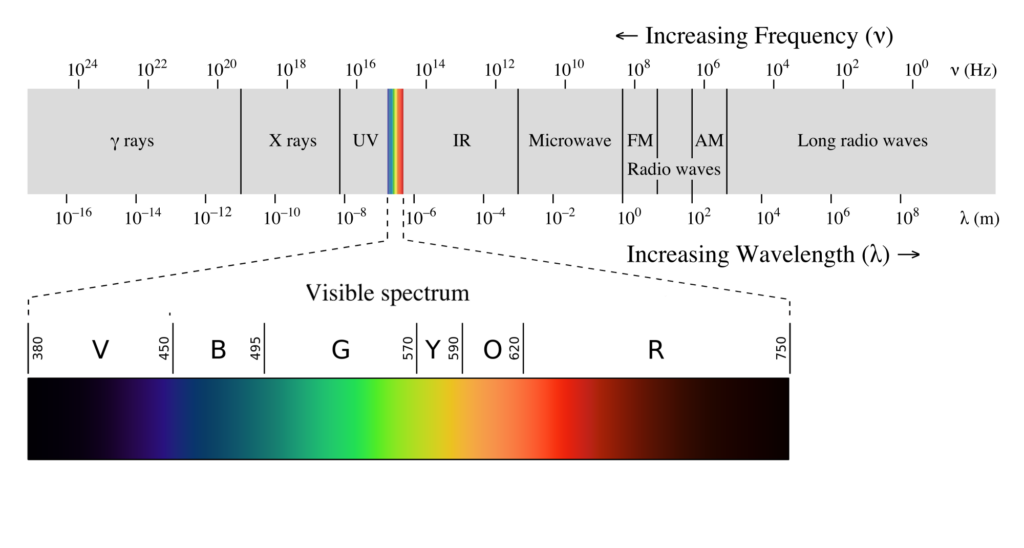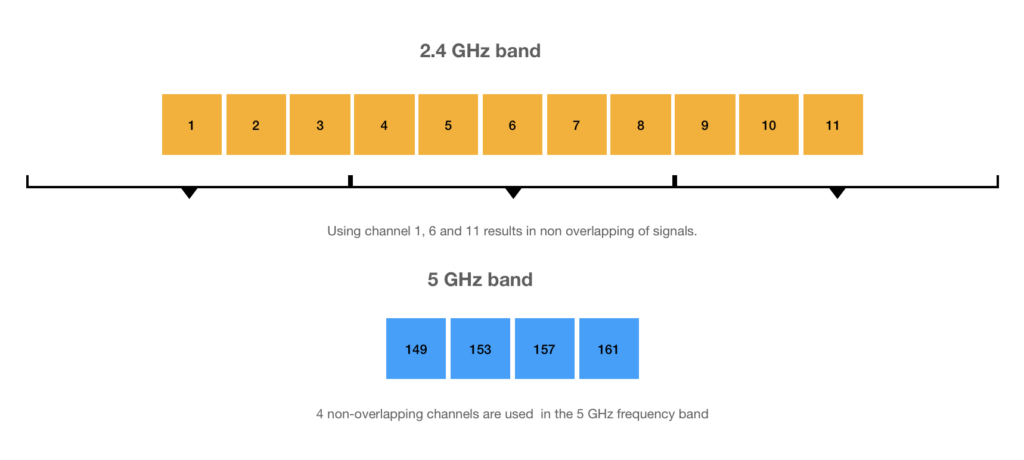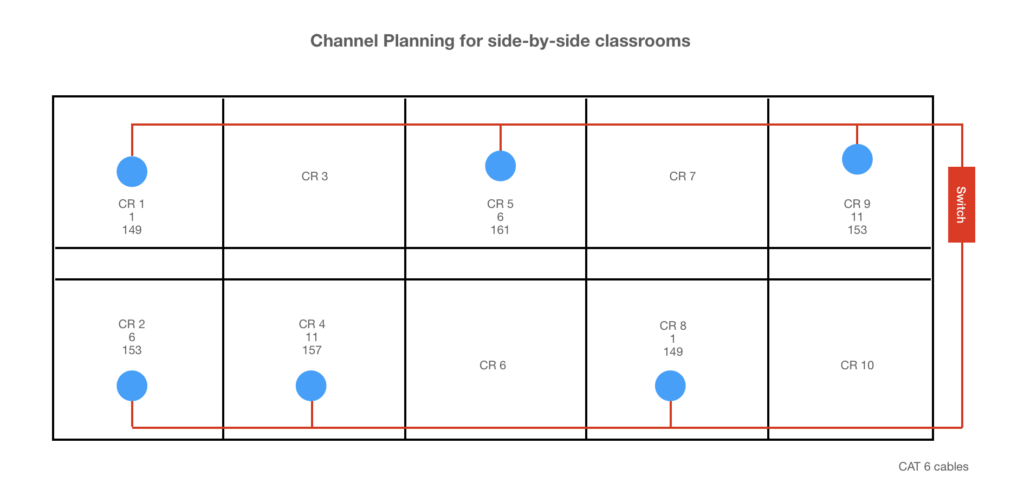With the introduction of BYOD programs, it is crucial for schools to provide wireless networks to the school communities. The school environment presents a challenging scenario to set up a reliable wireless network. I am going to describe the design and implementation of the wireless network in a school that I worked with. After the new implementation, each classroom was able to achieve an average of 60 – 80 Mbps. This school subscribes to an 80 Mbps internet plan, which is considered a fast plan in Jakarta.
The original network
When I started working in the school, there were Wi-Fi signals throughout the school. Teachers were also provided with LAN cables at their work stations as it was well known that the Wi-Fi signals were unreliable.
These were what I discovered:
- The Wi-Fi signals were primarily provided by multiple TP-Link TL-WA7210N outdoor access points.
- The channels were all set to auto. As such, little channel planning was put into the Wi-Fi design.
- There were multiple SSIDs used by the different access points.
Basic knowledge on Wi-Fi technology
Wi-Fi is based on radio waves. As part of the electromagnetic waves, its frequency spans across from 30 Hz to 300 GHz. To visualise this, a radio wave of 30 Hz has a wavelength of 10,000 km while 300 GHz has a wavelength of 1 mm.

The frequency of a radio wave is continuous. When we mentioned a certain frequency, we are in fact describing a band of frequencies from x Hz to y Hz. There are two frequencies used in the Wi-Fi technology.
The older band 2.4 GHz has a higher penetration power. This was in accordance to the earlier wireless principle to provide higher coverage. Higher penetration means the signals could pass through the classroom walls. The later 5 GHz became popular around 2009. 5 GHz signals have lower penetration, but they contain more data and data transfer is faster as a result. With more devices now, the new Wi-Fi principle is to provide higher capacity.
Radio waves obey the laws of Physics. Two waves overlapping experience superposition. If the frequencies are different, the superposition is transient and the original data is retained. However if the frequencies are similar, the dreaded interference occurs.
Interference occurs when two waves of similar frequencies overlapped. The changes in the radio wave intensities occur over a longer duration, distorting the signals as a result. This causes devices to take longer time to download the data than otherwise.
To reduce this effect, Wi-Fi technology implemented the idea of channels. There are channels 1 – 13 in the 2.4 GHz band. When you transmit a signal from channel 1, you are in fact transmitting a radio wave of frequency peaked at 2.412 GHz. Since radio wave frequencies are continuous, you will also be transmitting frequencies lower and higher than 2.412 GHz, albeit at lower intensities. In practical terms, this means some frequencies belonging to channel 2(2.417 GHz) and channel 3(2.422 GHz) are also transmitted at the same time with your signal from channel 1. When your neighbouring access point transmit signals at channel 2, there will be significant overlapping of your signals.
With this idea, the usual channel planning for 2.4 GHz band is to use only channels 1, 6 and 11. A channel 1 signal uses up to channel 3 while a channel 6 signal uses from to channel 4 to channel 8. Using channel 1 and 6 side-by-side will not cause much interference as a result. The same idea applies to the 5 GHz band. There are also more channels allocated to the 5GHz band, allowing us to plan for more access points without interference. In Indonesia however, this advantage was practically eliminated when it allows only 4 usable channels in the 5 GHz band, thus having only one more channel advantage over the 2.4 GHz band.

To summarise this knowledge, when planning for wireless coverage, we need to consider the 2.4 GHz and the 5 GHz penetration and data capacity, as well as the channel management between different access points.
The design
We understand why the original Wi-Fi was unreliable. The access points used were designed for outdoor usage. This required the access points to transmit the signals at high power. Used indoors, the signal from one AP reached numerous classrooms. Coupled with multiple APs with little channel considerations, we have interference occurring throughout the campus. An analogy would be to have multiple speakers tuned to the maximum volume and blasting the audio across the different classrooms. This explained why users complained that they could connect to the Wi-Fi, but got very slow connections(like you could hear the sound from the speakers, but hard to figure out what was being projected from the speakers).
Below are some decisions I made with regard to the new implementation.
Both 2.4 GHz and 5 GHz would be used.
Although the 5 GHz is preferred, the classrooms that were not installed with the AP could utilise the 2.4 GHz band better as it has better penetration.
I also discovered that there were some teachers and students using devices that support only the 2.4 GHz band. This made it not possible to deactivate the 2.4 GHz unless these users upgrade their devices or purchase a 5 GHz Wi-Fi adapter.
There should be a common SSID for all users.
This is for security purpose. School users should only connect to the specified SSIDs. A malicious user would not be able to create a hotspot with the similar SSID because I would be able to detect them from my controller.
Channel planning should be done to ensure as little interference occurs as possible
This is of utmost importance because we were going to use BYOD devices regularly and accessing the internet reliably for learning activities is crucial.
The implementation
I started with one level of the learning block. As I have limited budget, I wanted to maximise the investment by having one access point covering multiple classrooms. I decided to choose Ubiquiti’s UniFi line of access points for their enterprise capabilities and the cost.
The classroom level for implementation had 10 classrooms. I placed the access points at alternate classrooms. Considering that I only have four 5GHz channels (149, 153, 157 and 161) and three 2.4GHz channels(1, 6 and 11) available, I charted out the channels used by the individual access points.

The access points were connected to the switches with CAT 6 cables. On hindsight, CAT 5e cables would suffice because the UniFi AP AC Lite supports up to 867 Mbps on 5 GHz and up to 300 Mbps for 2.4 GHz, just slightly above the 1 Gbps supported by CAT 5e. CAT 5e cables are also much more economical.
One extra AP was installed in Classroom 2. This was determined after the first install of all the APs. Connectivity test in Classroom 2 shows that the network was unreliable, while Classroom 10 was good. This testing is crucial to fine tune the blind spots that were not covered adequately.
I created two SSIDs, one for the 5 GHz and the other for the 2.4 GHz. This is to allow users to choose the band that is most suitable for their device. Although the devices were supposed to choose the appropriate bands, this was not always reliable.
The original TP-Link APs were taken taken offline after the installations.
The result
After installing the UniFi access points, we were able to get average 60 – 80 Mbps in the classrooms where the APs were installed, and 30 – 40 Mbps for the remaining classrooms.
Each UniFi AP AC Lite cost about USD100. Covering the entire level cost USD600. This is considerably more affordable than contemporary rivals from Cisco and Motorola.
The school proceed to install the remaining levels with similar access points and existing access points of different brands. The concepts of channel planning and common SSID were applied throughout the campus.